Contes Blasco Ibañez – Route 1
Dades bàsiques
Between 1 hour and a half and 2 hours
Bullring
Birthplace of San Vicente Ferrer
The first route of Tales of Blasco Ibañez allows you to rediscover existing spaces such as the bullring and others that have already disappeared such as the Puerta de San Vicente and the Penal de San Agustín, even others on whose plots there are buildings with very different uses, such as the prison of Sant Gregori. From there, and following the street of the boats, we will reach the church of the Patriarch to finally find the Pouet de Sant Vicent.
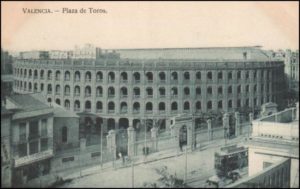
A Sunday of suffocating July; one afternoon when the streets of Valencia seemed deserted, under the blazing sun and a bonfire wind that came from the rough plains of the interior. All people were in the bullfight or in the ears of the sea.
In this itinerary, we will reach the historic center of the city starting from the south. As a reference we use the story “Un hallazgo”, in which the inmate Magdalena, after leaving prison, is “recruited” by the fierce Chamorra to commit a robbery, taking advantage of the fact that the owners of the house could be attending a bullfight. They would be, therefore, in the cusp of Xàtiva street, a place that opened its doors for the first time in the bullfighting show on June 22, 1859. Until then, party fans had had to go to the Market Square or other squares in the city where removable buildings were built. But on the initiative of Governor Melchor Ordóñez, in 1850 construction began on the current square, according to the project of Sebastián Monleón Estellés, on the site where there had previously been another unfinished building.
Declared a National Historic-Artistic Monument in the 80s, the building is inspired by the amphitheater of Nîmes, and its neoclassical style is complemented by the neomudéjar style recognizable in the exposed tile used to make the 384 arches (escarsiers on the ground floor, and semicircular on the three upper floors) that open on its façade.
Blasco Ibáñez attended the stands of the bullring as a spectator on a few occasions. Throughout his life he maintained an ambiguous attitude towards the bullfighting tradition, although the brushstrokes with which he describes this show in the novel Sagne y arena do not represent him much less as an enthusiastic amateur.
Friendly faces were animated at St. Vincent’s Gate; Higher category feminines, due to an old bed to load the steering and with no other fatigue to pull from the branch, shouting in the streets the famous proclamation: «Ama, is there manure?»
Along Xàtiva street, we continue west, until we cross the route supposedly followed by the protagonist of the story «El femater». We remember that, as a child, Nelet was sent to the city to collect garbage and contribute, in this way, to the survival of the family. It came from the orchards of the south of Valencia, and in its advance had to run into the gate of San Vicente. Located in front of the church of San Agustín, in what is now the square of the same name, it was one of the twelve gates (of the four large portals) that opened into the old Christian wall of the city. That is, between 1356 and 1370, maintaining the primitive Islamic wall as protection, another fortification was built (with a perimeter of 4 km) that incorporated the new suburbs and whose gates allowed better communication. St. Vincent’s was set up as a tower with a door that was demolished in 1830. It would replace another with three hollows, on which were placed the sculptures of San Vicente Mártir and San Vicente Ferrer, oriented in the opposite direction and made by the artist of French origin Carlos José Cloostermans.

All the friends who were absent by will or strength spoke to Sali: Uncle Tripa, who had died a saint after a life of thunder; the Donsainers, eight in Buenos Aires for such badly daunted blows, that the matter could not be fixed even by the same governor of the province; and the minor people who were in St. Augustine or San Miguel de los Reyes, innocents who braved themselves without first having good protectors.
In the vicinity of the Plaza de San Agustín, more specifically next to the church of the same name and the plot of the Treasury building (Guillem de Castro street), there was another space, already disappeared (it was demolished in 1904), which is mentioned in the story “Valencian Guapeza”. The brothers Bandullo and Pepet, after deciding to make peace, go to share a paella in a hamlet on the Burjassot road. They are accompanied by other “nice” and “brave”, although all lament the absence of other colleagues who have ended up in president. This was the function performed for a time by the monastery of San Miguel de los Reyes, current headquarters of the Valencian Library, and also ended up having a religious building such as the convent of San Agustín.
It was built during the fourteenth century, and had two cloisters, which denotes its large dimensions. But, as a result of the confiscation of Mendizábal, it became a penal, being the kings themselves who would take care of its reform, since in 1812 it was used as a barracks by the Napoleonic troops and the facilities were quite deteriorated. The low height of its outer walls and the poor security conditions, which led to the repeated escapes of prisoners, made it advisable to sell it to build a new prison enclosure. However, after its demolition, the first supply market in the city was installed in the space it occupied.
Good parishioners had that morning the café of El Cubano. The flower of the handsome, the most valuable braves who roamed Valencia on their own merits; All those who lived in the style of a knight wandering by the force of his arm, those who formed the guard of doors at the helms, those who carried their share of terror in the banks, those who were shooting or slamming in the streets, without ever trooping, by virtue of secretly immune, with the door of the presidio, They were there, drinking in sorbos Aguardiente’s morning copite, with the gravity of good bourgeois who go to their businesses.
The coffee shop was served at the request of an enthusiastic admirer, looking out of the eye at all those famous faces, and there was no shortage of people from the neighborhood who soomated onlookers, at the door, signaling with the gift to the most known.
Once again, the story “Valencian Guapeza” helps us to walk from Plaza de San Agustín to Avenida del Oeste. As soon as we entered it, on the corner of Nuestra Señora de Gracia and Semma streets, we find the place where that café to which the narrator alludes was located and that by the nature of its customers should not be an establishment of very good reputation. This drinks place that no longer exists was open years before its reform in 1903, the year in which it was advertised in El Poble, highlighting the economic price of its liquors and, especially, the quality of its bottles of absinthe and vermouth. In September 1907, however, the same newspaper advertised the transfer of the business.

During the day, with the bellicose instrument hanging from his skin or caressing it with one end of the blossom so that he lost the vase with which he was chased by the wetness of the jail, he went all over the building, an old convention in refectories, barns and vanes, admonished with sweaty confusion about a thousand men.
Connecting with San Vicente Mártir street, heading north we will reach the place where one of the most popular theaters in the city currently stands. By chance of fate, on the site occupied by the Olympia was located a penalty where Blasco Ibáñez was imprisoned on several occasions for his articles and journalistic campaigns against the Restoration regime. It is true that within the enclosure his situation was much better than that suffered by the inmate Magdalena in the story “A find”, but his impressions of the state of St. Gregory conformed to reality.
After the confiscation of Mendizábal, a building that had had a long history became a prison. Its origins are linked to the attempt to remove “sinful public women” from the streets (fourteenth century). In the middle of the sixteenth century, these women were taken on certain festivities to the House of Repentance, with a charitable purpose and aimed at promoting their reintegration. But as the doctrines of the Counter-Reformation were imposed, the House was transformed into a convent (1601), offering the repentant the option of dedicating themselves to religious life.
The convent-penal of San Gregorio was demolished in 1911, coinciding with the inauguration of the Model Prison. Instead, announced by the press of the time, “it is planned to build a block of modern houses to revitalize this central area. It is also planned to build a theater that will be baptized with the name of Olympia” (The Provinces).
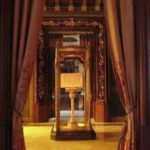
As you walk through the Plaza del Ayuntamiento, you cannot miss the opportunity to visit the Municipal Historical Museum in the same Town Hall, where valuable pieces of the city’s historical and artistic heritage are exhibited.
[Pepet] The riverside said he was not afraid or disturbed by the Bandullos. There was nothing but to see him at eleven o’clock in the evening marching down the street of the Barcas with unpregnant confidence.
A few meters away from San Vicente street, is the Plaza del Ayuntamiento, which we will cross to reach the street of Les Barques. There was a time when, if you did not have the courage of characters like the “beautiful” Pepet, from the story “Valencian Guapeza”, it could be dangerous to travel along this road. It was a street that bordered the old neighborhood of Pescadors, an area where once settled the people who lived from fishing and calafates, but that gradually was transformed into a place where cafes, taverns and brothels were located, and with this began to be frequent fights, scandals and crimes, until, in 1907, the neighborhood was demolished and reordered urbanly.
This street, also known in the past as Vall Cubert (passing through a ditch that transported the city’s wastewater: Valladar), was longer than today: it started in the Plaza del Ayuntamiento and went back to the vicinity of the Plaza de Alfonso el Magnánimo.
At number 30 of this road was the old bookshop of Francisco Sempere, who was a friend and publishing partner of Blasco Ibáñez. Almost immediate to this establishment was the Café Español or Iborra, on the corner of Carrer de les Barques and Pascual i Genís, where a group of followers of Rodrigo Soriano carried out an attack on the novelist on September 11, 1905.
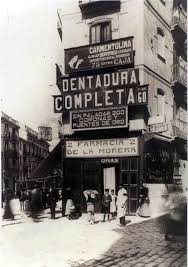
[Pepet] He was already in the wake of the mulberry tree, when a shot sounded and the brave man felt the blow on his shoulder, at the same time that his sight was clouded and his ears humbled.
Just in front of the aforementioned Café Español, was one of the busiest places in the city today and where the protagonist of the story “Valencian Guapeza” was shot down by the Bandullo brothers. We are referring to the rise of La Morera, an immediate space where the Bank of Valencia building (La Caixa) currently stands, on the other side of the Main Theater. Already in documents of the fourteenth century there is talk of the existence of a mulberry tree that bordered the house of a certain Pere Puig, so the place where it was located received the name of Plaça de la Morera de Pere Puig. When the old tree was felled in 1767, another mulberry tree was planted in its place that would survive until the last third of the nineteenth century. This second mulberry tree knew, therefore, how the square of Pere Puig became of the Barques and in it was the fountain of the three Graces, moved over time to the Plaza de Rodrigo Botet.
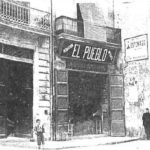
At number 14 Calle Don Juan de Austria, Blasco Ibáñez set up his home and the editorial office of the newspaper El Pueblo in 1894, so he knew the Pescadors neighbourhood very well.
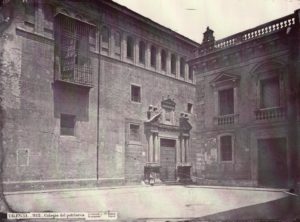
All Valencians have feared children before the monster nestled in the atrium of the Colegio del Patriarca, the church founded by Blessed Juan de Ribera. It is a straw crocodile, with its short and rough legs stuck to the wall and its huge mouth, with an expression of disgusting horror that makes the little ones recoil, hunting in the lap of their mothers.
Taking as reference the first lines of the story “The Patriarch’s Dragon”, we then direct our steps towards Calle de la Nave, to reach the Patriarch Seminary College, also known as the Royal College of Corpus Christi. Declared a National Historic-Artistic Monument in 1962, this building was promoted by Juan de Ribera, archbishop and viceroy of Valencia, who wanted to found a seminary for the training of priests according to the guidelines of the Counter-Reformation and, in addition, intervened directly in the design of the architectural project and in the choice of artists and builders who would intervene in its construction.
The school was built in barely twenty-four years (1586-1610), and although its façade conveys a sense of austerity, valuable treasures are kept inside. Worthy of mention are the frescoes by Bartolomé Matarana for his church and the Renaissance cloister, by Guillén del Rei, with columns of Genoese marble. But we must not forget the contents of its archive, nor the pictorial works of Ribalta, El Greco or Joan de Joanes that houses its museum or the splendid tapestries recently restored and that adorn the Capella dels Tapissos.
However, one of the curiosities of the building is the dissected alligator that, as the narrator of the aforementioned story says, is hung on the wall to the left of the atrium or vestibule and gave pabulum to the creation of a legend with almost epic accents.

Her lion was as respectable a glory as the Silk Lonja or the Pozo de San Vicente.
To reach the last stop of this first itinerary, we continue along Carrer de la Nau to Plaça d’Alfons el Magnànim, from where, crossing Carrer de Paz, we will reach Carrer del Mar. Our destination is the birthplace of the patron saint of Valencia, San Vicente Ferrer, between the aforementioned Calle del Mar and Calle del Pouet. Of this building, mentioned as an authentic institution for the Valencians in the story “The last lion”, there remains only the plot where the new building of the mid-twentieth century stands, in neo-Gothic style. In the new building there are spaces such as the vestibule, whose walls represent various scenes of the miracles attributed to San Vicente, graphically embodied in the ceramic tiles of Manises of the eighteenth century. It is this religious dimension that overshadows the possible historical value of a house that once belonged to the guild of bonneteros or to the Dominican order. Christian piety vindicates the portentous miracles of the saint, and among them stands the one related to the old well that was in the family home. It is that of “the slipper”, through which the boy Vicente caused the water from the well to rise to its board so that a friend of his could recover the shoe that had fallen to the bottom. According to tradition, the waters of that well were inexhaustible and could even be comfort for the afflicted.